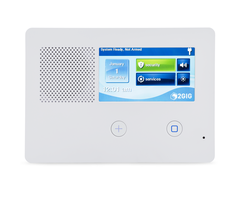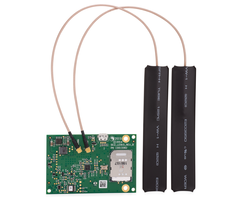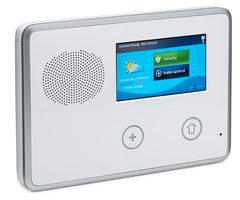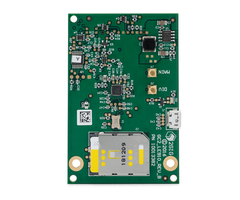How Do I Upgrade a 2GIG GC2e to Use LTE?
You cannot upgrade a 2GIG GC2e to use LTE. The GC2e is unaffected by the 3G Sunset, as it never used 3G or CDMA modules. The system is too new, and 3G and CDMA activations were no longer allowed by the time it was released. A cellular communicator is needed for alarm monitoring service.
 When someone talks about "upgrading" a security system to LTE, they are usually talking about the 3G Sunset. This refers to the shutdown of older 3G, 4G, and CDMA cellular towers in favor of newer LTE and 5G technology. In the world of security, any alarm system that uses cellular connectivity will lose service if its associated cellular network is shutdown. Any user with an alarm system using 3G or CDMA communication will need to upgrade that system to a newer cellular network, typically LTE. That is why you will often hear about this big push to "upgrade to LTE" before the 3G Sunset.
When someone talks about "upgrading" a security system to LTE, they are usually talking about the 3G Sunset. This refers to the shutdown of older 3G, 4G, and CDMA cellular towers in favor of newer LTE and 5G technology. In the world of security, any alarm system that uses cellular connectivity will lose service if its associated cellular network is shutdown. Any user with an alarm system using 3G or CDMA communication will need to upgrade that system to a newer cellular network, typically LTE. That is why you will often hear about this big push to "upgrade to LTE" before the 3G Sunset.
For the GC2e though, the 3G Sunset doesn't really apply. The GC2e is too new of a system, and all of its activations as of February 2021 have used LTE cellular communicators. The LTE cellular communicators for the GC2e System include the 2GIG LTEA-A-GC2 AT&T LTE Communicator, the 2GIG LTEV1-A-GC2 Verizon LTE Communicator, and the 2GIG LTEV-A-GC2 Verizon LTE Communicator. It's possible that a newer 5G communicator might be released for the GC2e System someday. But at the time of this writing, only LTE is available for installation and activation.
Important Note: LTEV1-A-GC2 and LTEA-A-GC2 communicators manufactured in late 2022 or early 2023 require the 2GIG GC2 to have firmware 1.19.4+ and the 2GIG GC2e to have firmware 1.24+. See this article for more information. The packaging for affected communicators should show the firmware version required.
The 2GIG GC2e needs cellular connectivity for communication with the Alarm.com servers. Alarm.com forwards incoming signals to a central station and/or the end user directly via text, email, and/or push notifications. This is what makes alarm monitoring service possible. Sometimes, you may hear about a GC2e user "upgrading to LTE" to get the system monitored. In such cases, they aren't really upgrading from an older cellular network, but rather they installing a cellular communicator inside the panel for the first time.
You should also be aware that activating a cellular communicator for a GC2e Panel will require a monitoring plan that supports cellular connectivity. Some examples of compatible monitoring plans include the Gold and Platinum Plans from Alarm Grid (Self or Full) and the Alarm Grid Cellular-Only Plan. We advise exploring different monitoring plans and choosing the one that best meets your unique needs. Remember, Alarm Grid monitoring plans are all no-contract, and they never include any added fees. If you have any questions about our monitoring services, then we are happy to discuss them with you via email at support@alarmgrid.com. We respond to email inquiries from 9am to 8pm ET M-F.
Complete the following steps to install and activate an LTE cellular communicator for a 2GIG GC2e System:
1. Power down the panel. Whenever you are making hardware changes, you must first power down the panel. This is done by disconnecting the backup battery and unplugging the transformer. You will need to open up the panel to disconnect the battery. You can keep the panel open, as you will need to install the communicator to the board anyway.
2. Install the communicator. Now that your system is powered down, you can install the communicator. But before you do this, you should write down the IMEI number for the module. You will need this number when you go to activate the module later. The IMEI number can usually be found on a sticker on the communicator, or it may be somewhere on the product's packaging. Make sure to save this information, as you may need to access the IMEI number sometime in the future. As for the actual installation process, refer to the instruction manual for the communicator, and make sure to follow all the listed steps carefully.
3. Power panel back on. With the communicator successfully installed, you can now power the panel back on. Reconnect the backup battery since you already have the panel open. You can then reconnect the panel transformer and close the panel. The system should power back on.
4. Activate the LTE communicator. You will need to contact your monitoring company to have them activate the communicator. New Alarm Grid customers must schedule an activation slot when signing up for a monitoring plan. Existing Alarm Grid customers can contact us via email at support@alarmgrid.com to determine a good time to activate the communicator. Remember, the IMEI number for your communicator will be needed to activate the module.
5. Test cellular signals. Now that the communicator is active, your monitoring company should test its cellular signals. This is important because a system receiving weak cellular signals will not work reliably, and it could fail to communicate with Alarm.com. Your monitoring company will be able to determine if the cell signals are good enough or if additional action is needed. Weak cellular signals can usually be addressed using a cellular antenna or a cellular amplifier.
Did you find this answer useful?
We offer alarm monitoring as low as $10 / month
Click Here to Learn MoreRelated Products



Related Videos
Related Categories
- LTE Cellular Communicators
- LTE Cellular Communicators
- AT&T LTE Cellular Communicators
- Verizon LTE Cellular Communicators
- Answered


